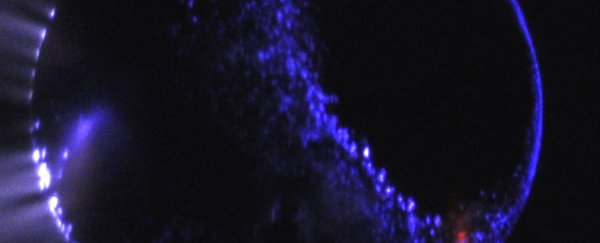NASA's MAVEN mission has confirmed the appearance of several bright blue aurorae that would have made an awfully pretty sight from the ground on Mars. According to the data collected by the spacecraft as it orbited the red planet 1,000 times on 6 April 2015, these are the first known aurorae to be visible by the naked eye on a terrestrial planet other than Earth.
While the aurorae actually appeared way back in 2005, detected by the SPICAM imaging instrument on-board the European Space Agency's (ESA) satellite, Mars Express, it's taken 10 years for scientists at NASA to confirm the event. Various recreations in the lab and a physical numerical model confirmed that the flashing lights given off by the cosmic phenomenon - which is caused by high-energy solar particle rays, solar wind and magnetospheric plasma interacting with the atoms and molecules of a planet's upper atmosphere - occurred in the visible range of light wavelengths.
While on Earth, the aurorae we see - such as Aurora Borealis, which appears most clearly over Norway and the Svalbard island - give off mostly red and green light, these Martian aurorae would have been predominantly blue, and an astronaut looking up from the surface of Mars would have been able to make out slightly red and green hues, the researchers report in the journal Planetary and Space Science.
As the MAVEN team explains in a NASA press release, the reason Mars is lucky enough to host its own beautiful aurorae is that even though its global magnetic field shut down around 3.5 billion years ago, local pockets of increased magnetic fields - known as crustal magnetic anomalies - have accumulated in its southern hemisphere. This is where these aurorae are most likely to occur in the future.
"Our planetary research gives us good insight on physics in the Martian atmosphere - how it evolved, why Mars' mass is different than Earth's," said one of the team, Guillaume Gronoff from NASA's Langley Research Centre in the US. "It helps us to better understand planetary atmosphere emissions, ultimately helping us to discover habitable planets."
Definitely something for our future Mars colonists to look forward to.
 D. Bernard/IPAG — CNRS
D. Bernard/IPAG — CNRS
